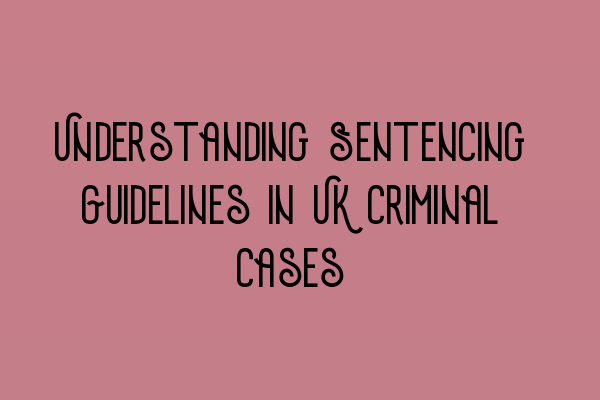Understanding Sentencing Guidelines in UK Criminal Cases
When it comes to criminal cases in the UK, understanding the sentencing guidelines is crucial. Sentencing guidelines provide a framework for judges and magistrates to determine the appropriate punishment for a particular offense. These guidelines ensure consistency and fairness in the sentencing process.
What Are Sentencing Guidelines?
Sentencing guidelines are documents created by the Sentencing Council for England and Wales. They outline the factors that judges and magistrates should consider when sentencing individuals convicted of criminal offenses. The guidelines take into account the seriousness of the offense, the culpability of the offender, and any mitigating or aggravating factors.
By following the sentencing guidelines, judges and magistrates can ensure that similar offenses receive similar punishments, regardless of the jurisdiction. This helps to maintain public trust in the criminal justice system and promotes fairness.
It’s important to note that sentencing guidelines are not mandatory, but they are highly influential. Judges and magistrates must have regard to the guidelines and provide clear reasons if departing from them.
Factors Considered in Sentencing
When determining an appropriate sentence, judges and magistrates consider various factors:
- The nature and seriousness of the offense: This includes considering the harm caused, the level of planning or premeditation involved, and any use of violence.
- The offender’s role and culpability: The level of involvement, leadership, or coercion exerted by the offender plays a significant role.
- The presence of aggravating or mitigating factors: Aggravating factors, such as previous convictions or a high degree of harm, may increase the severity of the sentence. Conversely, mitigating factors, like a genuine show of remorse or a lack of previous convictions, may reduce the sentence.
- Community impact and public interest: The impact of the offense on the community and the public’s interest in bringing the offender to justice are also considered.
By assessing these factors, judges and magistrates can determine the appropriate punishment that reflects the specific circumstances of the case.
Understanding Sentencing Ranges
Sentencing guidelines often provide a range of sentences for each offense category. Judges and magistrates consider the specific circumstances of the case to determine where within the range the sentence should fall.
For example, let’s consider a case of theft. The sentencing guidelines may provide a range of imprisonment from 3 to 8 years for theft offenses. The judge or magistrate will consider factors such as the value of the stolen goods, the level of planning involved, and the offender’s role in the crime. Based on these considerations, the judge or magistrate will determine the appropriate sentence within the provided range.
Appellate Review of Sentencing
It’s important to note that sentencing decisions are subject to appellate review. If either the prosecution or the defense believes that the sentence imposed is manifestly excessive or unduly lenient, they can appeal to a higher court.
The higher court will consider whether the sentencing judge or magistrate made an error in principle or if the sentence was outside the range of what could be considered appropriate for the offense committed.
Conclusion
Understanding the sentencing guidelines in UK criminal cases is essential for both legal professionals and individuals involved in the criminal justice system. These guidelines promote consistency, fairness, and public trust in the sentencing process. By considering the nature of the offense, the offender’s culpability, and aggravating or mitigating factors, judges and magistrates can determine the appropriate sentence that reflects the specific circumstances of each case.
For more information on related topics, please visit the following articles:
- Essentials of Consideration: Understanding the Backbone of Contracts
- Mistake in Contract Law: Unraveling the Impact on Agreement Validity
- Assignment of Contracts: Rights, Obligations, and Legal Considerations
- Agreements in Contract Law: Determining Legally Binding Commitments
- Counter-offers: The Art of Negotiating in Contract Law
